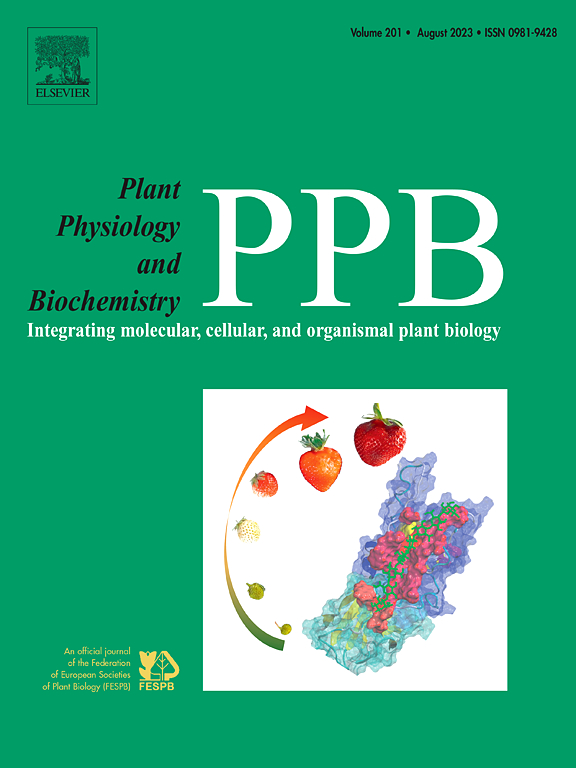通过扩大血管直径、激活抗氧化酶和加强渗透调节来适应高盐环境
IF 5.7
2区 生物学
Q1 PLANT SCIENCES
引用次数: 0
摘要
盐生植物已经进化出各种适应盐环境的机制。然而,它们的形态解剖变化,以及在盐碱地中对盐胁迫增加的根代谢反应,仍然知之甚少。摘要本研究旨在探讨沙豆科植物在4种盐碱地(非盐碱地;NS,淡盐水;LS,中度生理盐水;多发性硬化症,重度生理盐水;通过结合成像和代谢组学技术分析其解剖形态特征、营养成分和根差异代谢物。结果表明,盐胁迫显著增加了叶片多肉质、根管直径和表皮厚度。与NS处理相比,叶片周长分别增加11.48%、28.29%和47.94%;根管直径分别增加11.07、24.39和14.31 % (p <;0.05)。MS和SS处理的根表皮厚度分别比NS处理增加了24.34%和109.37% (p <;0.05)。高盐胁迫破坏了叶片叶绿体和线粒体膜,丙二醛(MDA)含量在LS、MS和SS处理下分别增加了32.45%、73.36%和112.96% (p <;0.05)。抗氧化酶活性(过氧化氢酶;猫,过氧化物酶;POD,超氧化物歧化酶;SOD含量在LS、MS和SS处理下分别显著升高49.25 ~ 71.89%、90.64 ~ 278.86%和12.94 ~ 116.37% (p <;0.05)。土壤盐分升高使根、茎、叶的钠钾比分别提高223 ~ 518%、215 ~ 330%和303 ~ 524%;钠/钙(Na/Ca)比在根中增加99 ~ 180%,茎中增加842 ~ 1810%,叶中增加1111 ~ 2901%。此外,与半乳糖/丙氨酸、天冬氨酸和谷氨酸相关的根代谢途径显著增强,导致l -天冬氨酸、β-丙氨酸、甘氨酸、半乳糖醇、甘油和半乳糖醛酸上调。因此,盐生植物通过大量的形态、生理和代谢调节来应对盐度胁迫,从而突出了它们强大的适应机制。本文章由计算机程序翻译,如有差异,请以英文原文为准。

Suaeda salsa adapts to high-salt environments through expanding vessel diameter, activating antioxidant enzymes and strengthening osmotic regulation
Halophytes have evolved various mechanisms to adapt to saline conditions. However, their morpho-anatomical changes, along with the root metabolic responses to increased salt stress in saline-alkali soils, remain poorly understood. This study aimed to elucidate the adaptive mechanisms of Suaeda salsa under four saline-alkali soil levels (non-saline; NS, lightly saline; LS, moderately saline; MS, and severely saline; SS) by analyzing their anatomical morphological traits, nutritional components, and root differential metabolites through a combination of imaging and metabolomics technologies. Results showed that increased salt stress markedly enhanced leaf succulence, root vessel diameter, and epidermal thickness. Compared to NS treatment, leaf perimeter increased by 11.48, 28.29 and 47.94 %, respectively; root vessel diameter increased by 11.07, 24.39 and 14.31 % (p < 0.05). Root epidermal thickness increased by 24.34 and 109.37 % in MS and SS treatments, compared to NS treatment (p < 0.05). High salt stress disrupted leaf chloroplast and mitochondrial membranes, as indicated by malondialdehyde (MDA) increases of 32.45, 73.36 and 112.96 % in LS, MS and SS treatments (p < 0.05). Antioxidant enzyme activities (catalase; CAT, peroxidase; POD, superoxide dismutase; SOD) significantly increased in LS, MS, and SS treatments by 49.25–71.89 %, 90.64–278.86 %, and 12.94–116.37 %, respectively (p < 0.05). Elevated soil salinity increased sodium/potassium (Na/K) ratios by 223–518 % in roots, 215–330 % in stems, and 303–524 % in leaves; sodium/calcium (Na/Ca) ratios increased by 99–180 % in roots, 842–1810 % in stems, and 1111–2901 % in leaves. Additionally, root metabolic pathways associated with galactose/alanine, aspartate, and glutamate were markedly enhanced, leading to the upregulation of L-aspartate, β-alanine, glycine, galactinol, glycerol, and galactonic acid. Consequently, halophytes highlight their robust adaptive mechanisms by substantial morphological, physiological, and metabolic adjustments in response to salinity stress.
求助全文
通过发布文献求助,成功后即可免费获取论文全文。
去求助
来源期刊
CiteScore
11.10
自引率
3.10%
发文量
410
审稿时长
33 days
期刊介绍:
Plant Physiology and Biochemistry publishes original theoretical, experimental and technical contributions in the various fields of plant physiology (biochemistry, physiology, structure, genetics, plant-microbe interactions, etc.) at diverse levels of integration (molecular, subcellular, cellular, organ, whole plant, environmental). Opinions expressed in the journal are the sole responsibility of the authors and publication does not imply the editors'' agreement.
Manuscripts describing molecular-genetic and/or gene expression data that are not integrated with biochemical analysis and/or actual measurements of plant physiological processes are not suitable for PPB. Also "Omics" studies (transcriptomics, proteomics, metabolomics, etc.) reporting descriptive analysis without an element of functional validation assays, will not be considered. Similarly, applied agronomic or phytochemical studies that generate no new, fundamental insights in plant physiological and/or biochemical processes are not suitable for publication in PPB.
Plant Physiology and Biochemistry publishes several types of articles: Reviews, Papers and Short Papers. Articles for Reviews are either invited by the editor or proposed by the authors for the editor''s prior agreement. Reviews should not exceed 40 typewritten pages and Short Papers no more than approximately 8 typewritten pages. The fundamental character of Plant Physiology and Biochemistry remains that of a journal for original results.

 求助内容:
求助内容: 应助结果提醒方式:
应助结果提醒方式:


